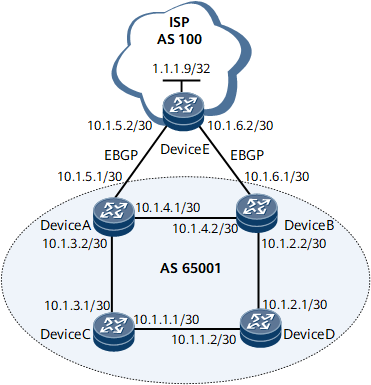IGP Cost
BGP prefers the route with the smallest IGP cost during BGP route selection.
Run the display bgp routing-table [ ip-address ] command on Device C and Device D to check the configurations. Device C is used as an example.
# Display the routing table of Device C.
[~DeviceC] display bgp routing-table BGP Local router ID is 10.1.1.1 Status codes: * - valid, > - best, d - damped, x - best external, a - add path, h - history, i - internal, s - suppressed, S - Stale Origin : i - IGP, e - EGP, ? - incomplete RPKI validation codes: V - valid, I - invalid, N - not-found Total Number of Routes: 4 Network NextHop MED LocPrf PrefVal Path/Ogn *>i 1.1.1.9/32 10.1.5.2 0 100 0 100i * i 10.1.6.2 0 100 0 100i *>i 10.1.5.0/30 10.1.3.2 0 100 0 i *>i 10.1.6.0/30 10.1.2.2 0 100 0 i
The preceding command output shows that two routes 1.1.1.9/32 are available in the routing table of Device C and that Device C selects the route learned from Device A.
[~DeviceC] display bgp routing-table 1.1.1.9 BGP local router ID : 10.1.1.1 Local AS number : 65001 Paths: 2 available, 1 best, 1 select BGP routing table entry information of 1.1.1.9/32: From: 10.1.3.2 (2.2.2.9) Route Duration: 00h00m44s Relay IP Nexthop: 10.1.3.2 Relay IP Out-Interface: GigabitEthernet0/1/8 Original nexthop: 10.1.5.2 Qos information : 0x0 AS-path 100, origin igp, MED 0, localpref 100, pref-val 0, valid, internal, best, select, active, pre 255 Not advertised to any peer yet BGP routing table entry information of 1.1.1.9/32: From: 10.1.2.2 (10.1.2.2) Route Duration: 00h00m39s Relay IP Nexthop: 10.1.1.2 Relay IP Out-Interface: GigabitEthernet0/1/00/1/0 Original nexthop: 10.1.6.2 Qos information : 0x0 AS-path 100, origin igp, MED 0, localpref 100, pref-val 0, valid, internal, pre 255, IGP cost 2, not preferred for IGP cost Not advertised to any peer yet
The preceding command output shows that the route with next hop address 10.1.6.2 is ignored because its IGP cost is larger than that of the other route. Table 1 describes the attribute comparison of the routes learned from Device A and Device B.
Route Attribute |
Route Learned from Device A |
Route Learned from Device B |
Comparison |
|---|---|---|---|
PrefVal |
0 |
0 |
The same. |
Local_Pref |
100 |
100 |
The same. |
Route type |
Learned from a peer |
Learned from a peer |
The same. |
AIGP |
- |
- |
The same. |
AS_Path |
100 |
100 |
The same length. |
Origin |
IGP |
IGP |
The same. |
MED |
0 |
0 |
The same. |
Peer type |
IBGP |
IBGP |
The same. |
IGP cost |
- |
2 |
The route learned from Device A is optimal. NOTE:
If a BGP route carries no IGP cost value, BGP considers its IGP cost to be 0. If no IGP routes are used during BGP peer relationship establishment or the costs of used IGP routes are 0, the IGP cost is not displayed in the display bgp routing-table ip-address command output. |
